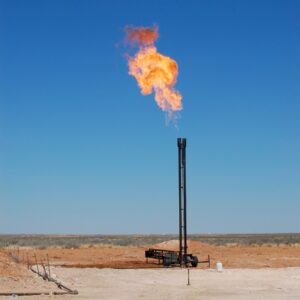 Natural Gas Facts
Natural Gas FactsNatural gas is the gas produced by oil and natural gas wells that comes from reservoirs beneath the surface of the earth. Just as the crude oil produced by a well must be refined, natural gas must also be processed before it can be used by consumers. One significant difference between the two is that natural gas is often required to be purified, to some extent, before it can be transported through pipelines. Therefore, some processing is done at the site of the well and further purification is done at a processing plant.
The natural gas that we use in our homes and for electricity is mostly methane. The natural gas that is produced from a well is mixed with other hydrocarbons, like propane and butane, and with other compounds like water vapor and possibly carbon dioxide and hydrogen sulfide. The other hydrocarbons, called natural gas liquids, are valuable enough to be sold separately.
If the natural gas is dissolved in oil, the two have to be separated. This is generally done with equipment at the well-site. Similarly, water in a liquid state can be separated from the gas on site. Water vapor in solution with the gas is more difficult to remove, and this is done either through condensation or dehydration.
Once the natural gas is at the processing plant, further purification can take place. Natural gas containing sulfur (in the form of hydrogen sulfide) is called sour gas and gives off a noticeable smell. Sour gas can be corrosive and even harmful to breathe. If sulfur is present it can be removed (or “sweetened”) by what is called the amine process. The gas is forced through a tower containing amine, which acts to absorb the sulfur. There is also a process for taking the sulfur element out of the hydrogen sulfide, and this makes it possible to use or sell the sulfur. Sulfur is widely used in fertilizers.
The processing plant is also where useful natural gas liquids are separated from the methane. The liquids are first separated from the natural gas, and then they are separated from each other. The liquids may be separated from the gas by an absorbing process, similar to the one used on the sulfur that will generally absorb most of the heavier liquids. However, the lighter liquids (like ethane) may remain. Sometimes, it is more practical to leave these lighter liquids in the natural gas. They can be removed by cooling the gas to very cold temperatures, which causes the ethane and other liquids to condense while the methane remains a gas. Since they each have distinct boiling points, natural gas liquids can be separated by essentially boiling them off one by one.
The various products of natural gas have many different uses. Propane and butane can be used for heating and energy. Pentane, another natural gas liquid, is used in many things including polystyrene foam. Isobutane is used as refrigerant, a propellant for aerosol, and foam products. It has significantly less impact on the ozone than the chlorofluorocarbons that perform similar functions.
The most significant product of natural gas processing is methane commonly referred to as natural gas. The U.S. Energy Information Administration (EIA) estimates that natural gas was responsible for twenty-five percent of the electricity produced in the U.S. in 2011. This represents an increase from thirteen percent in 1993, and the EIA projects continued growth through 2040.
Natural gas is a growing industry. Hydraulic fracturing and other techniques for obtaining oil and gas have made previously uneconomic or low volume wells viable sources of hydrocarbons. Wells are being drilled in many new places, and the United States’ supply of natural gas is expected grow significantly in the coming years. This increase in supply is a major factor in the projected growth of the use of natural gas for electricity.
Natural gas can be used as fuel for automobiles, as compressed natural gas can power engines much like other fuels. Some countries have had success with compressed gas, particularly with buses and other forms of public transportation that benefit from the lower fuel costs. Congress and some local governments have used incentives and tax credits to encourage the use of compressed gas vehicles in the U.S.
The cold weather had a substantial impact on natural gas. Based on heating degree days (a measurement of the energy used to heat buildings), the EIA estimated that the winter of 2013-2014 was ten percent colder than the average winter over the past decade. The huge increase in demand led to record amounts of natural gas being withdrawn from storage. This led to a significant increase in the price of propane, with prices more than doubling in the Midwest between the beginning of December and the end of January, though the prices did return closer to normal by the start of March. In some markets, like New England, prices hit a record high. Our need for, and dependence on, natural gas for heating and electricity is expected to increase keeping demand for this natural source of energy high.
To be considered an accredited investor, one must have a net worth exceeding one million US dollars, excluding the value of one's primary residence, or have income at least $200,000 each year for the last two years (or $300,000 combined income if married) and have the expectation to make the same amount this year.
Information on this website is for educational purposes only and is not an offer or solicitation to sell securities
SEO and Oil and Gas Web Design by Wilstar Media
